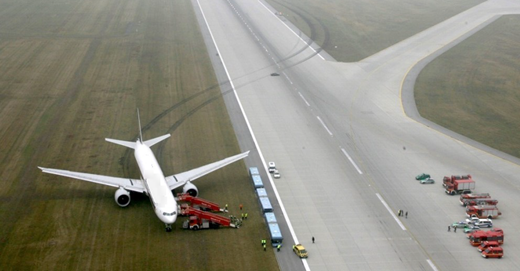Runway Safety Areas (RSAs)

Runway safety areas (RSAs) serve as the primary safety mitigation for runway excursions. A runway excursion is a veer off or overrun of an aircraft from the runway surface. Runway excursions also include aircraft that undershoot (land short of) the runway surface or land adjacent to the runway surface. Taxiway safety areas (TSAs) provide similar safety mitigation for taxiway excursions.
Safety areas preserve the same characteristics that pioneer aviators sought for airfields in the days before paved runways: smooth and clear grading; good drainage; load bearing capability; and the absence of non-essential and non-frangible objects. Airports today maintain these same characteristics throughout their determined RSAs to prevent aircraft damage and/or injury to aircraft occupants in the event of a runway excursion. Safety areas also support aircraft rescue and fire fighting (ARFF) equipment and snow removal equipment (SRE).
In essence, safety areas provide additional space and time for runway excursion aircraft to stop safely. Functionally, safety areas provide energy management for runway excursion aircraft. They reduce the severity of a runway excursion by safely dissipating the runway excursion aircraft’s kinetic energy (movement) while preserving its potential energy (fuel load) until it deaccelerates to a complete stop.
RSA Dimensions
Standard RSA dimensions encompass the area around a runway where runway excursions are most likely to occur. The airspeed and size of the runway’s critical aircraft, along with the runway’s visibility minimums, provide the primary factors to determine a runway’s standard RSA dimensions. The airport planning process identifies the applicable critical aircraft.
Airport operators determine the dimensions of each runway’s RSA by incorporating all available land within the runway’s standard RSA dimensions that is capable of supporting safety area characteristics. Ideally, the determined RSA dimensions match the standard RSA dimensions, meaning that all land within the standard RSA dimensions is RSA compatible. This constitutes a standard RSA.
Determined RSA dimensions must exclude land that is incapable of supporting RSA characteristics. Such land is referred to as RSA incompatible area. Where RSA incompatible area exists within the standard RSA dimensions (i.e., the determined RSA dimensions do not match the standard RSA dimensions) the RSA is considered nonstandard. The FAA encourages all airports with nonstandard RSAs to seek opportunities to expand their RSA compatible land or reconfigure their runways to meet standard RSA dimensions.
RSA Determinations & Inventories of Objects
RSA determinations and inventories of objects located within RSAs reside in the FAA’s Airport Data and Information Portal (ADIP).
Data, Tools, & Resources
- Airport Data and Information Portal (ADIP)
- Video: Runway Safety Area and Runway Incursion Mitigation Programs
- Runway Safety: Runway Excursions
Regulations & Guidance
Regulations
- Title 14 CFR Part 139 - Airport Certification
Provides regulatory requirements for safety areas at certificated airports
Orders, ACs, & Other Guidance
- Advisory Circulars (ACs) - All 150 Series Airport ACs
- Advisory Circular 150/5000-17 - Critical Aircraft and Regular Use Determination (current version)
Provides information to determine a runway’s critical aircraft - Advisory Circular 150/5070-6 - Airport Master Plans (current version)
- Advisory Circular 150/5220-23 - Frangible Connections (current version)
Provides information to construct FAA approved frangible structures - Advisory Circular 150/5300-13 - Airport Design (current version)
Provides information to determine standard safety area dimensions and to design and maintain standard safety area characteristics - Draft Series 150 Airport ACs
- Advisory Circular 150/5000-17 - Critical Aircraft and Regular Use Determination (current version)
- Airport Orders
- Engineering Briefs (EBs)
- See EB 79A - Determining RSA NAVAID Frangibility and Fixed-By-Function Requirements
- See EB 103 - Engineered Materials Arresting System Retroreflective Markers
- Airports Standard Operating Procedures (SOPs)
- See SOP 8.0 - Standard Operating Procedure for Runway Safety Area Determination
